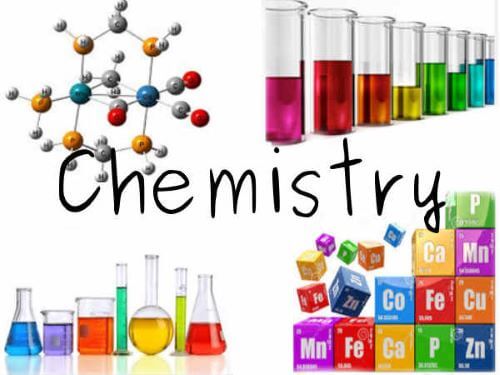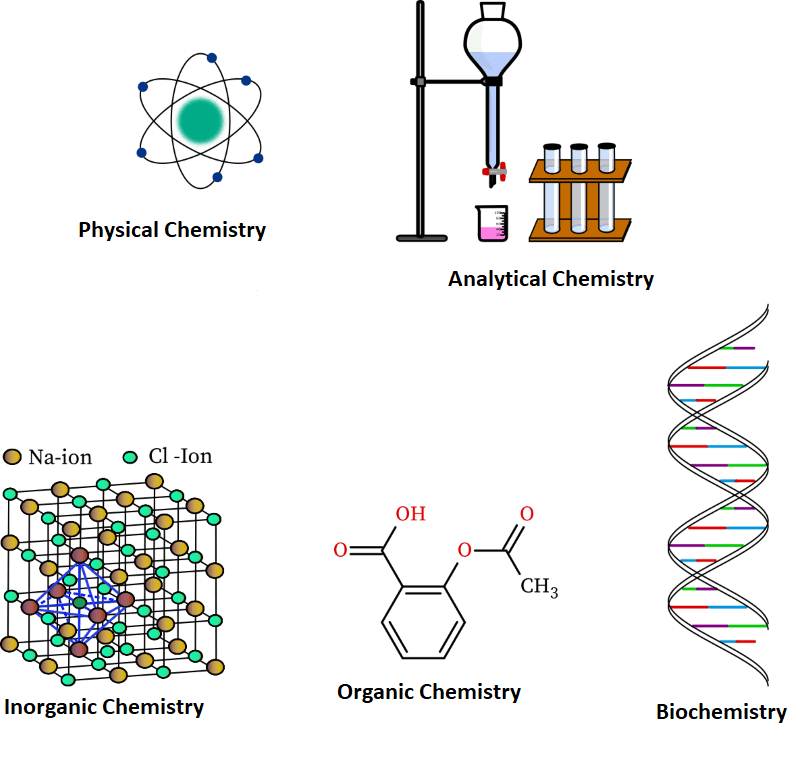What is chemistryIt is the branch of science that deals with the study of structure, composition, reactions, properties and applications or uses of matter. It mainly focuses on the atom, ions, molecules and the elements and compounds formed by them. Besides this, the interaction between matter and energy is also studied in chemistry. The father of chemistry is Lavoisier. The basic definition of chemistry is the study of matter and its properties. 
Chemistry is a part of our daily life. Chemical reactions are happening continuously around us and in our body. The food we eat goes through chemical reactions to produce energy, movement of muscles while walking, running, etc., also involve chemical reactions. Let us see some of the examples in our daily lives that involve chemistry, such as;
Chemistry is divided into five main branches that include organic chemistry, inorganic chemistry, physical chemistry, analytical chemistry and biochemistry. 
1) Organic chemistryThis branch deals with the study of organic compounds; the compounds made of carbon and hydrogen or in which carbon atoms are bonded with hydrogen such as carbonic compounds. It mainly focuses on the structure and chemical composition of organic compounds including their physical and chemical properties and the chemical reactions, which they undergo. The research and development in organic chemistry have made lots of contributions to human life such as production of the drugs, vaccines, polymers and other useful products. Besides this, synthetic organic chemistry, an important part of organic chemistry, deals with the construction of particular chemical compounds from simple compounds for practical purposes. Organic chemistry is very diverse due to the special property of the carbon element, which is known as carbon catenation. It allows an element to form bonds with the same type of atoms. This property of carbon allows it to form stable bonds with other carbon atoms and thus to form complex and stable molecules. The father of organic chemistry is Friedrich Wohler. Applications of organic chemistry:
So, most of the products that we use involve organic chemistry such as furniture, vehicle, food, sugars, computers, etc. Besides this, every living thing in this world is organic. Even, inorganic substances like rocks, air, water, and metals usually contain organic matter. 2) Inorganic ChemistryThis branch deals with the study of elements and their compounds other than hydrocarbons. For example, the study of carbon but not compounds in which carbon is bonded with hydrogen (compounds other than organic compounds). We can say that it is opposite to that of organic chemistry where we study compounds containing carbon atoms bonded to hydrogen atoms. The father of inorganic chemistry is Alfred Werner. In inorganic chemistry, we study the behaviour, properties, and physical and chemical characteristics of inorganic compounds. The inorganic compounds include crystal structures, minerals, metals, catalysts and most elements. So, it covers all materials which are not organic or which can be termed as non-living substances. The inorganic compounds that lack carbon-hydrogen bonding include metals, salts, chemical substances, and more. There are around 100000 inorganic compounds on the Earth. Applications of inorganic chemistry: Inorganic compounds have numerous uses or applications such as they can be used as catalysts, coatings, catalysts, surfactants, fuels, medicines, and more. For example;
3) Physical ChemistryIt deals with the study of rules and principles of reactions. The father of physical chemistry is Wilhelm Ostwald. It is the study of the behaviour of matter on a molecular and atomic level and how chemical reactions occur. It allows physical chemists to understand the formation of complex structures and to research and develop potential uses of new materials. It focuses on the physical structure of the chemical compounds or substances and the way they react with other substances. So, it also includes physical changes that occur during chemical reactions. It also makes use of concepts of physics to analyse the chemical properties of substances and their ability to react. We can say that physical chemistry uses both physics and chemistry to study the physical properties of substances. Importance or applications of physical chemistry:
Some examples of physical chemistry in our daily life:
4) Analytical ChemistryIt involves the study of the separation, identification and quantification of elements and compounds. It may use classical methods and modern methods or instruments. It also analyses the reaction of two compounds that react to form a third compound and the amount of reactants that reacted to form the third compound. We can say that it involves the following methods:
Methods used in Analytical Chemistry The methods, which are used in analytical chemistry, are divided into classical and instrumental methods. Classical Methods: There are various classical methods to check the presence or absence of a compound in the given sample or substance such as;
Instrumental Methods:
Analytical chemistry is further divided into two sub-branches, which are as follows; i) Quantitative analysis: It involves the measurement of absolute or relative quantity or concentration of one or more components present in the given sample. For example; when the chemists study a solid substance, first they use qualitative methods to identify the compound present in the sample. Then they use the quantitative analysis methods to find out the exact amount of that compound present in the sample. Some examples of quantitative analysis are Gravimetric Analysis and Volumetric analysis. ii) Qualitative Analysis: As the name suggests, it involves the determination of the quality of a particular compound irrespective of its quantity. So, in this method, only quality is measured, quantity is not measured. For example, a change in colour occurs or not in a chemical reaction. Various qualitative analysis methods are used in salt analysis to identify the cations or anions of inorganic salts. Applications of analytical chemistry:
5) Bio-chemistryIt deals with the study of chemical processes and changes occurring in living organisms or biological systems. It also studies the structure, composition and chemical reactions of substances or chemicals found in living systems. It uses chemistry along with biology to better understand the biological processes such as digestion, respiration, excretion, etc., and also studies biomolecules like carbohydrates, lipids, proteins, acids, DNA, RNA, etc. The father of biochemistry is Carl Neuberg. The term 'biochemistry' was also given by him. Biochemistry is further divided into the following main branches;
Applications or importance of biochemistry
Besides the above five branches, there are various other branches of chemistry that were introduced over time, such as industrial chemistry, nuclear chemistry, and more.
It is the study of industrial processes, which are used to convert raw material and their derivatives into products that are beneficial for humans. So, this branch of chemistry involves the study of physical and chemical methods and their use in the production of products on a large scale from raw materials. So, it involves the transformation of raw material and their derivatives into beneficial products. Applications of industrial chemistry: It is used to produce various beneficial products. For example; nitrogen and hydrogen are used to form ammonia (N2 + 3H2 → 2 NH3), which is used in the fertilizer industry to form ammonium nitrate fertilizer. Similarly, petroleum obtained from the earth's crust is converted to ethylene which is a derivative and is converted to polyethylene.
It focuses on the changes and properties of atomic nucleus whereas traditional chemistry mainly focuses on the electronic structure of atoms. We can say that it studies the effect of changes in the atomic nucleus on the physical and chemical properties of atoms or elements or molecules. Besides this, it also studies the radiations, nuclear reactions and their applications. Applications of nuclear chemistry
Next TopicWhat is Matter
|
 For Videos Join Our Youtube Channel: Join Now
For Videos Join Our Youtube Channel: Join Now
Feedback
- Send your Feedback to [email protected]
Help Others, Please Share









